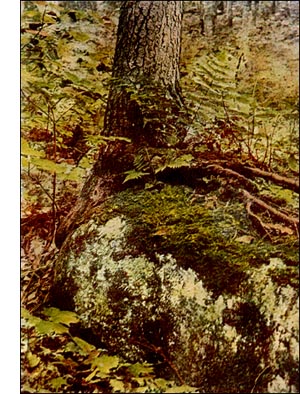Juniper Hairy Cap Moss
 Juniper Hairy-cap, Polytrichum juniperinum, Willd.
Juniper Hairy-cap, Polytrichum juniperinum, Willd.Habit and habitat.-Common by damp sandy roadsides, or in peat-bogs. This is one of the Hairy-caps which in dry air turns its leaves up against the sun in order 'to protect the delicate lamellae from his rays. It as well as P. piliferum, is conspicuous for its bluish-white bloom, but differs from P. piliferum in that the leaves are tipped with a short red awn instead of with one long, white, and hair-like.
Name. -Carl Ludwig Willdenow named this pretty moss juniperinum from its resemblance to tiny juniper trees.
Plant (gametophyte).-Simple or forked, erect, t to 4 inches high from subterranean shoots.
Leaves.-Erect, when dry, spreading when moist, lance-like; apex a rough red awn; base enlarged and sheathing; vein rough; margins entire, inflexed lamellae 40 to 50, 5 to 6 cells deep; cells square in section, the terminal 3-toothed. Bracts of male flower-cluster short and abruptly awned.
Leaves at the base of the pedicel (perichaetial leaves).-Sheathing, without lamellae.
Habit of flowering.-Male and female flowers on separate plants (dioicious).
Veil (calyptra).-Large, covering the spore-case.
Spore-case.-Erect, finally horizontal, 4-angled ; apophysis small, red, shield-like.
Pedicel (seta).-Red-orange, becoming brown, stout, glossy, 1 1/2 to 2 1/2 inches high.
Lid (operculum).-Red, flattened-convex with a short beak.
Teeth (peristome).-Pale, symmetrical, rather short, sixty-four in number.
Spores.-Ripe in summer.
Distribution.-From Florida to Alaska, also in Europe.